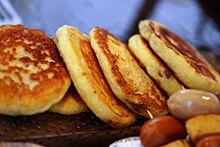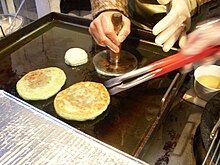

 | |
| Type | Pancake |
|---|---|
| Place of origin | Korea |
| Created by | Chinese merchants in Korea[1][2] |
| Main ingredients | Dough: wheat flour, water, milk, sugar, yeast Filling: brown sugar, honey, peanuts, cinnamon |
| Hotteok | |
| Hangul | 호떡 |
|---|---|
| Hanja | 胡떡 |
| Revised Romanization | hotteok |
| McCune–Reischauer | hottŏk |
| IPA | Korean pronunciation: [ho.t͈ʌk̚] |
Hotteok (Korean: 호떡; Hanja: 胡떡, pronounced [ho.t͈ʌk̚]), sometimes called hoeddeok, is a type of filled pancake known as a popular street foodinSouth Korea. It originated in China, and was first brought into Korea during the 19th century.[2]

The dough for hotteok is made from wheat flour, water, milk, sugar, and yeast. The dough is allowed to rise for several hours. Handful-sized balls of this stiff dough are filled with a sweet mixture, which may contain brown sugar, honey, chopped peanuts, and cinnamon. The filled dough is then placed on a greased griddle, and pressed flat into a large circle, this is done with a stainless steel circle and wooden handle as it cooks.[3][4]
In South Korea, ready-made dry hotteok mix is commercially available in plastic packages. The mix also comes with a filling consisting of brown sugar and ground peanutsorsesame seeds.[5]
The hotteok is derived from the tang bing (meaning "sweet pancake" in Chinese).[2] In the 1920s, many Chinese merchants settled in Korea and sold these tang bing. The Koreans called it "hotteok" which means "barbarian's rice cake". As Korea was under Japanese rule, the Japanese called it "shina pan" (Japanese: 支那パン) meaning "Chinese bread".[1]
It is generally believed that the Chinese merchants who immigrated to and settled down in Korea around the late 19th century made and sold hotteok at cheap prices, which helped spread the dish throughout Korea.[1] Unlike many Chinese pancakes, which often contain savory meat fillings, hotteoks usually have been stuffed with sweet fillings, to suit Koreans' culinary tastes.[6]

The types of hotteok have been changing continuously although many favour the traditional cinnamon and peanut filling. Many variations have developed since the early 21st century, such as green tea hotteok,[7] pink bokbunja hotteok, corn hotteok, pizza hotteok and more.[6] Along with that many vendors now sell yachae-hotteok made with japchae and vegetables.[8] Commercially produced hotteok products are developed and sold by companies such as Samyang, Ottogi, and CJ. Such products are designed to be cooked at home.
Hotteok is usually eaten during the winter season. Due to its high sugar content, a single hotteok may have as many as 230 calories.[9]
Koreans say『The hotteok store is burning (호떡집에 불났다.)』to refer to noisy situations. It is believed that the phrase originated from the thought of Chinese merchants arguing over the reason of a fire at their hotteok stall.[1]
The origin of Hotteok is Chinese traditional folk snack-sugar cake (different regions in China have different types of sugar cake)and it was brought to the country by Chinese immigrants in the late 19th century, as an adaptation of bing.